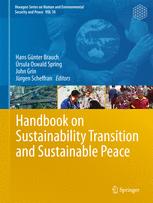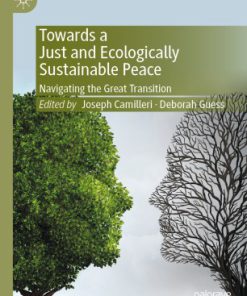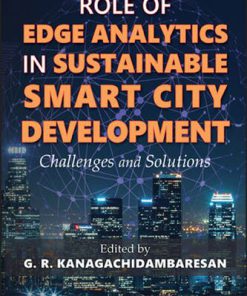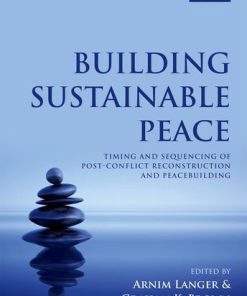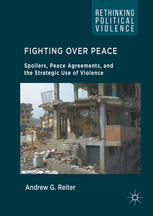Handbook on Sustainability Transition and Sustainable Peace 1st Edition by Hans Gunter Brauch, Ursula Oswald Spring, John Grin, Jurgen Scheffran ISBN 3319438840 9783319438849
$50.00 Original price was: $50.00.$25.00Current price is: $25.00.
Handbook on Sustainability Transition and Sustainable Peace 1st Edition by Hans Günter Brauch, Úrsula Oswald Spring, John Grin, Jürgen Scheffran – Ebook PDF Instant Download/Delivery: 3319438840, 9783319438849
Full download Handbook on Sustainability Transition and Sustainable Peace 1st Edition after payment
Product details:
ISBN 10: 3319438840
ISBN 13: 9783319438849
Author: Hans Günter Brauch, Úrsula Oswald Spring, John Grin, Jürgen Scheffran
In this book 60 authors from many disciplines and from 18 countries on five continents examine in ten parts: Moving towards Sustainability Transition; Aiming at Sustainable Peace; Meeting Challenges of the 21st Century: Demographic Imbalances, Temperature Rise and the Climate–Conflict Nexus; Initiating Research on Global Environmental Change, Limits to Growth, Decoupling of Growth and Resource Needs; Developing Theoretical Approaches on Sustainability and Transitions; Analysing National Debates on Sustainability in North America; Preparing Transitions towards a Sustainable Economy and Society, Production and Consumption and Urbanization; Examining Sustainability Transitions in the Water, Food and Health Sectors from Latin American and European Perspectives; Preparing Sustainability Transitions in the Energy Sector; and Relying on Transnational, International, Regional and National Governance for Strategies and Policies Towards Sustainability Transition. This book is based on workshops held in Mexico (2012) and in the US (2013), on a winter school at Chulalongkorn University, Thailand (2013), and on commissioned chapters. The workshop in Mexico and the publication were supported by two grants by the German Foundation for Peace Research (DSF). All texts in this book were peer-reviewed by scholars from all parts of the world.
Handbook on Sustainability Transition and Sustainable Peace 1st Table of contents:
Chapter 1: Foundations of Sustainability and Peace
1.1 Defining Sustainability: Environmental, Social, and Economic Dimensions
1.2 Understanding Peace: Positive vs. Negative Peace
1.3 The Link Between Sustainability and Peace
1.4 Global Challenges: Climate Change, Inequality, and Conflict
1.5 The Role of International Institutions and Policies
Chapter 2: The Concept of Sustainability Transition
2.1 What is a Sustainability Transition?
2.2 Theories and Frameworks of Transition (Multi-Level Perspective, Socio-Technical Transitions)
2.3 Drivers of Sustainability Transitions
2.4 Barriers to Sustainable Transitions in Society and Economies
2.5 The Role of Governance in Transitions
Chapter 3: Peacebuilding and Conflict Transformation
3.1 Theories and Models of Peacebuilding
3.2 Understanding Conflict Dynamics and Root Causes
3.3 Conflict Prevention vs. Post-Conflict Peacebuilding
3.4 Reconciliation and Justice in Peace Processes
3.5 The Role of Civil Society, Media, and Education in Peacebuilding
Chapter 4: Intersection of Sustainability and Peace
4.1 How Sustainability Contributes to Peacebuilding
4.2 Managing Natural Resources for Peace
4.3 Sustainable Economic Development in Conflict Zones
4.4 Climate Change and Its Impact on Peace and Security
4.5 Integrating Social Equity into Sustainability Transitions for Peace
Chapter 5: Policy and Governance for Sustainability and Peace
5.1 Policy Frameworks for Sustainability Transitions
5.2 Inclusive Governance in Peacebuilding and Sustainability
5.3 International Cooperation and Diplomacy for Sustainable Peace
5.4 Decentralized Governance and Local Peacebuilding
5.5 Multi-Stakeholder Approaches: Government, NGOs, and the Private Sector
Chapter 6: Sustainable Development Goals (SDGs) and Peacebuilding
6.1 The Role of the SDGs in Achieving Sustainability and Peace
6.2 SDGs 16: Peace, Justice, and Strong Institutions
6.3 Cross-Sectoral Linkages Between SDGs for Peace and Sustainability
6.4 Measuring Progress: Indicators and Monitoring
6.5 SDGs in Post-Conflict and Fragile Contexts
Chapter 7: Climate Change, Environmental Justice, and Conflict
7.1 The Impact of Climate Change on Conflict and Security
7.2 Environmental Justice and Its Role in Peacebuilding
7.3 Resilience and Adaptation Strategies in Conflict-Prone Regions
7.4 Mitigating Climate-Induced Migration and Displacement
7.5 Case Studies: Climate Conflict and Peacebuilding Solutions
Chapter 8: Economic Transition and Sustainable Peace
8.1 The Economics of Transitioning to a Sustainable Future
8.2 Green Economy and Conflict-Free Resource Management
8.3 Financing for Sustainability Transitions in Post-Conflict Contexts
8.4 Inclusive Economic Growth and Development for Peace
8.5 Building Resilient Economies Post-Conflict: Lessons from Practice
Chapter 9: Education for Sustainability and Peace
9.1 The Role of Education in Promoting Sustainability and Peace
9.2 Peace Education: Frameworks and Approaches
9.3 Teaching Sustainable Development in Conflict Zones
9.4 Strengthening Social Cohesion through Education
9.5 Education for Transition: Developing Skills for a Sustainable Future
Chapter 10: Human Rights, Gender, and Social Justice in Transition
10.1 The Role of Human Rights in Sustainability and Peace
10.2 Gender Equality and Women’s Empowerment in Peace Processes
10.3 Social Justice and Equity in Sustainable Transitions
10.4 Rights-Based Approaches to Sustainability and Peacebuilding
10.5 Case Studies on Human Rights and Gender in Post-Conflict Transition
Chapter 11: Technologies for Sustainability Transition and Peace
11.1 Role of Technology in Advancing Sustainability
11.2 Innovation for Peacebuilding: Digital Tools for Conflict Prevention
11.3 Renewable Energy Technologies and Peacebuilding
11.4 Technology for Social Mobilization and Advocacy in Conflict Zones
11.5 Ethical Considerations in Technology for Sustainability and Peace
Chapter 12: Case Studies of Sustainability Transitions and Peacebuilding
12.1 Case Study 1: The Role of Renewable Energy in Post-Conflict Recovery
12.2 Case Study 2: Peacebuilding in Resource-Rich Conflict Zones
12.3 Case Study 3: Climate Change Adaptation and Conflict Prevention
12.4 Case Study 4: Integrating Youth in Sustainable Development and Peace
12.5 Lessons Learned and Best Practices
Chapter 13: Future Directions in Sustainability Transition and Peacebuilding
13.1 The Evolving Concept of Sustainability in Peacebuilding
13.2 Emerging Threats and Opportunities: Globalization, Technology, and Governance
13.3 Future Trends in Peace and Sustainability Transitions
13.4 Engaging the Next Generation in Sustainability and Peace
13.5 Long-Term Visions for a Sustainable and Peaceful World
People also search for Handbook on Sustainability Transition and Sustainable Peace 1st:
Tags:
Hans Gunter Brauch,Ursula Oswald Spring,John Grin,Jurgen Scheffran,Handbook,Sustainability Transition,Sustainable Peace
You may also like…
Politics & Philosophy
Engineering - Civil & Structural Engineering
Biology and other natural sciences
Politics & Philosophy
Politics & Philosophy
Sustainable Nutrition in a Changing World 1st Edition Prof. Dr. Hans Konrad Biesalski
Politics & Philosophy
Politics & Philosophy - Social Sciences


